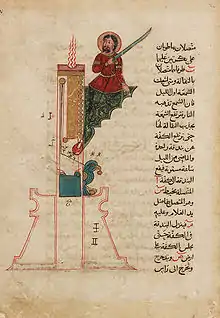Candle clock
A candle clock is a thin candle with consistently spaced marking that when burned, indicate the passage of periods of time. While no longer used today, candle clocks provided an effective way to tell time indoors, at night, or on a cloudy day. A candle clock could be easily transformed into a timer by sticking a heavy nail into the candle at the mark indicating the desired interval. When the wax surrounding the nail melts, the nail clatters onto a plate below.

History
It is unknown where and when candle clocks were first used. The earliest reference to their use occurs in a Chinese poem by You Jiangu (AD 520).[1] Here, the graduated candle supplied a means of determining time at night. Similar candles were used in Japan until the early 10th century.
You Jiangu's device consisted of six candles made from 72 pennyweights (24 grains each), of wax, each being 12 inches high, of uniform thickness, and divided into 12 sections each of one inch. Each candle burned away completely in four hours, making each marking 20 minutes. The candles were placed for protection inside cases made of a wooden frame with transparent horn panels in the sides.[2] Similar methods of measuring time were used in medieval churches and earlier, famously by King Alfred the Great of England, first by counting the number of candles of a specific size burnt, and later by use of a graduated candle.
Al-Jazari

The most sophisticated candle clocks known to date, however, were those of Al-Jazari in 1206.[3] It included a dial to display the time and, for the first time, employed a bayonet fitting, a fastening mechanism still used in modern times.[4] The English engineer and historian Donald Routledge Hill described one of al-Jazari's candle clocks as follows:-
The candle, whose rate of burning was known, bore against the underside of the cap, and its wick passed through the hole. Wax collected in the indentation and could be removed periodically so that it did not interfere with steady burning. The bottom of the candle rested in a shallow-dish that had a ring on its side connected through pulleys to a counterweight. As the candle burned away, the weight pushed it upward at a constant speed. The automata were operated from the dish at the bottom of the candle.[3]
References
- Turner, Anthony J. The Time Museum, Volume I, Time Measuring Instruments; Part 3, Water-clocks, Sand-glasses, Fire-clocks
- Rodgers, Leo. "A Brief History of Time Measurement". NRICH. Retrieved 4 November 2017.
- Rodgers, Leo. "A Brief History of Time Measurement". NRICH. Retrieved 4 November 2017.
- Donald Routledge Hill, "Mechanical Engineering in the Medieval Near East", Scientific American, May 1991, pp. 64-9 (cf. Donald Routledge Hill, Mechanical Engineering Archived 2007-12-25 at the Wayback Machine)
- Ancient Discoveries, Episode 12: Machines of the East, History Channel, retrieved 2008-09-07
